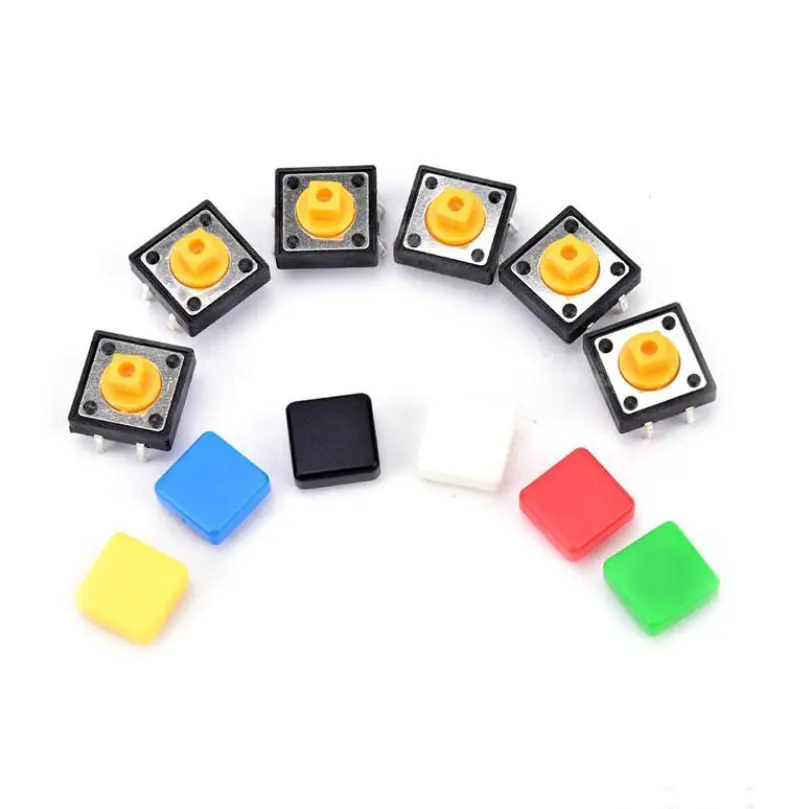Tactile switches are the unsung heroes of modern electronics, bridging human interaction with digital systems through their signature “bump” feedback. These switches, celebrated for their responsiveness and durability, have evolved significantly since their inception in the 1980s. Today, they power everything from gaming keyboards to industrial machinery. Let’s dive into their mechanics, applications, and top picks for 2025.
What Are Tactile Switches?
Tactile switches are electromechanical components that provide physical feedback—a noticeable bump or click—when pressed. This feedback confirms successful actuation, making them ideal for applications requiring precision, such as typing or gaming26. Unlike linear switches, which lack tactile feedback, or clicky switches, which add an audible click, tactile switches focus on a balance of subtlety and responsiveness12.
Key Components:
- Top Cover: Protects internal parts and transmits force from the user.
- Plunger: Translates external pressure into mechanical action.
- Contact Dome: A metal dome that collapses to complete the circuit, generating tactile feedback.
- Molded Resin Base: Ensures structural stability213.
How Do Tactile Switches Work?
When the plunger is pressed, the contact dome collapses, closing the circuit and producing tactile feedback. Releasing the plunger resets the dome, breaking the circuit. This design ensures immediate confirmation of input, critical for typing accuracy or rapid gaming commands.
Types of Tactile Switches
- Miniature/Micro Tactile Switches: Compact for space-constrained devices like wearables.
- Flush Tactile Switches: Low-profile design for sleek consumer electronics.
- Illuminated Tactile Switches: Integrate LEDs for visual feedback in dim environments.
- Dual Circuit Technology (DCT) Switches: New in 2025, models like the Littelfuse KSC2 DCT feature SPDT functionality and a 3.5mm actuator height, enabling faster response and reliability in medical or automotive applications.
Applications of Tactile Switches
- Consumer Electronics: Keyboards, remote controls, and gaming controllers (e.g., Akko V3 Cream Blue Pro for budget builds).
- Industrial Control Panels: Used in automation systems for precise input.
- Medical Devices: Critical for electrosurgical tools requiring reliability.
- Gaming: Tactile feedback enhances performance in MMOs and rhythm games (e.g., Kailh Speed Copper for rapid inputs).
Top Tactile Switches for 2025
Based on extensive testing and user feedback, here are the standout options:
- Best Overall: Gazzew Boba U4T (62g)
- Features a rounded tactile bump and deep “thocky” sound.
- Light factory lube ensures smooth operation.
- Ideal for typists and gamers seeking balance.
- Premium Choice: Gateron Zealio V2 (67g)
- Sharp, snappy tactility with customizable spring weights.
- Requires lubing and filming for optimal performance.
- Mid-Range Performer: Durock Sunflower/POM T1
- Crisp tactile bump and clacky sound.
- POM housing improves smoothness over time.
- Budget Pick: Akko CS Ocean Blue
- Light 45g actuation and factory lube for a smooth, affordable build.
- Gaming Specialist: Kailh Speed Copper
- Short pre-travel and subtle bump for rapid keystrokes.
- Silent Option: TTC Silent Bluish White
- Reduces noise while retaining a tactile feel, perfect for shared spaces.
Maintenance Tips
To prolong switch life and enhance performance:
- Lubrication: Use low-viscosity lubes like Krytox 205g0 on stems and springs.
- Filming: Apply switch films to reduce wobble (e.g., Gazzew Boba U4T benefits from films.
- Break-In Period: Most switches smooth out after 5,000–15,000 keystrokes.
Conclusion
Tactile switches are a cornerstone of modern electronics, offering precision and satisfaction across industries. Whether you’re a gamer seeking speed, a typist craving feedback, or an engineer designing compact devices, 2025’s lineup—from the thocky Gazzew Boba U4T to the innovative Littelfuse KSC2 DCT—has something for everyone. Explore these options to elevate your next project or build!

